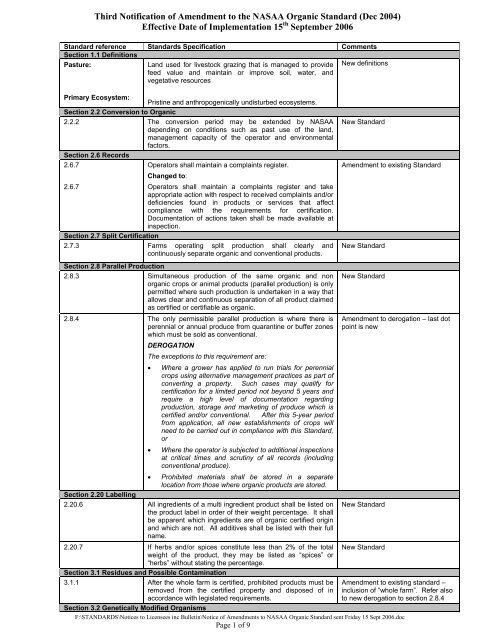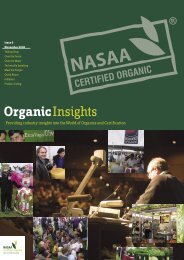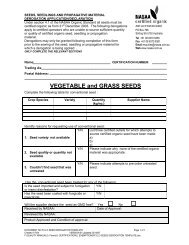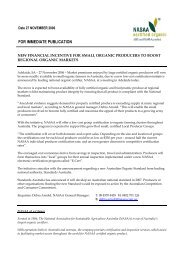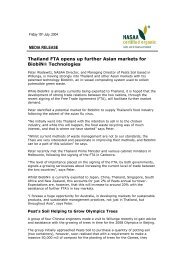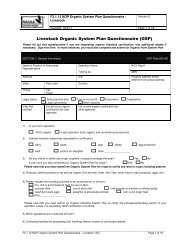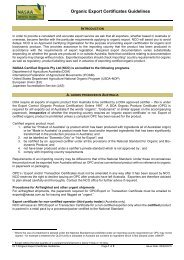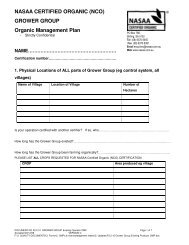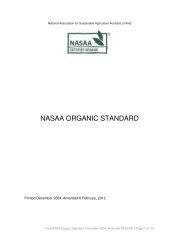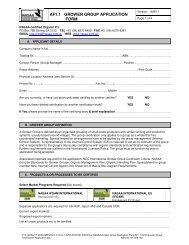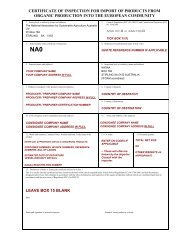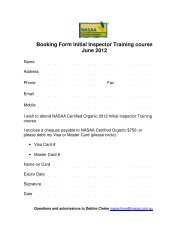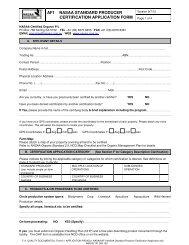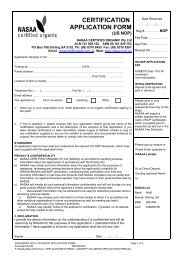Third Notification of Amendment to the NASAA Organic Standard ...
Third Notification of Amendment to the NASAA Organic Standard ...
Third Notification of Amendment to the NASAA Organic Standard ...
You also want an ePaper? Increase the reach of your titles
YUMPU automatically turns print PDFs into web optimized ePapers that Google loves.
<strong>Third</strong> <strong>Notification</strong> <strong>of</strong> <strong>Amendment</strong> <strong>to</strong> <strong>the</strong> <strong>NASAA</strong> <strong>Organic</strong> <strong>Standard</strong> (Dec 2004)<br />
Effective Date <strong>of</strong> Implementation 15 th September 2006<br />
<strong>Standard</strong> reference <strong>Standard</strong>s Specification Comments<br />
Section 1.1 Definitions<br />
Pasture:<br />
Land used for lives<strong>to</strong>ck grazing that is managed <strong>to</strong> provide New definitions<br />
feed value and maintain or improve soil, water, and<br />
vegetative resources<br />
Primary Ecosystem:<br />
Pristine and anthropogenically undisturbed ecosystems.<br />
Section 2.2 Conversion <strong>to</strong> <strong>Organic</strong><br />
2.2.2 The conversion period may be extended by <strong>NASAA</strong><br />
depending on conditions such as past use <strong>of</strong> <strong>the</strong> land,<br />
management capacity <strong>of</strong> <strong>the</strong> opera<strong>to</strong>r and environmental<br />
fac<strong>to</strong>rs.<br />
Section 2.6 Records<br />
2.6.7<br />
Opera<strong>to</strong>rs shall maintain a complaints register.<br />
Changed <strong>to</strong>:<br />
2.6.7<br />
Opera<strong>to</strong>rs shall maintain a complaints register and take<br />
appropriate action with respect <strong>to</strong> received complaints and/or<br />
deficiencies found in products or services that affect<br />
compliance with <strong>the</strong> requirements for certification.<br />
Documentation <strong>of</strong> actions taken shall be made available at<br />
inspection.<br />
Section 2.7 Split Certification<br />
2.7.3 Farms operating split production shall clearly and<br />
continuously separate organic and conventional products.<br />
Section 2.8 Parallel Production<br />
2.8.3 Simultaneous production <strong>of</strong> <strong>the</strong> same organic and non<br />
organic crops or animal products (parallel production) is only<br />
permitted where such production is undertaken in a way that<br />
allows clear and continuous separation <strong>of</strong> all product claimed<br />
as certified or certifiable as organic.<br />
2.8.4 The only permissible parallel production is where <strong>the</strong>re is<br />
perennial or annual produce from quarantine or buffer zones<br />
which must be sold as conventional.<br />
DEROGATION<br />
The exceptions <strong>to</strong> this requirement are:<br />
• Where a grower has applied <strong>to</strong> run trials for perennial<br />
crops using alternative management practices as part <strong>of</strong><br />
converting a property. Such cases may qualify for<br />
certification for a limited period not beyond 5 years and<br />
require a high level <strong>of</strong> documentation regarding<br />
production, s<strong>to</strong>rage and marketing <strong>of</strong> produce which is<br />
certified and/or conventional. After this 5-year period<br />
from application, all new establishments <strong>of</strong> crops will<br />
need <strong>to</strong> be carried out in compliance with this <strong>Standard</strong>,<br />
or<br />
• Where <strong>the</strong> opera<strong>to</strong>r is subjected <strong>to</strong> additional inspections<br />
at critical times and scrutiny <strong>of</strong> all records (including<br />
conventional produce).<br />
• Prohibited materials shall be s<strong>to</strong>red in a separate<br />
location from those where organic products are s<strong>to</strong>red.<br />
Section 2.20 Labelling<br />
2.20.6 All ingredients <strong>of</strong> a multi ingredient product shall be listed on<br />
<strong>the</strong> product label in order <strong>of</strong> <strong>the</strong>ir weight percentage. It shall<br />
be apparent which ingredients are <strong>of</strong> organic certified origin<br />
and which are not. All additives shall be listed with <strong>the</strong>ir full<br />
name.<br />
2.20.7 If herbs and/or spices constitute less than 2% <strong>of</strong> <strong>the</strong> <strong>to</strong>tal<br />
weight <strong>of</strong> <strong>the</strong> product, <strong>the</strong>y may be listed as “spices” or<br />
“herbs” without stating <strong>the</strong> percentage.<br />
Section 3.1 Residues and Possible Contamination<br />
3.1.1 After <strong>the</strong> whole farm is certified, prohibited products must be<br />
removed from <strong>the</strong> certified property and disposed <strong>of</strong> in<br />
accordance with legislated requirements.<br />
New <strong>Standard</strong><br />
<strong>Amendment</strong> <strong>to</strong> existing <strong>Standard</strong><br />
New <strong>Standard</strong><br />
New <strong>Standard</strong><br />
<strong>Amendment</strong> <strong>to</strong> derogation – last dot<br />
point is new<br />
New <strong>Standard</strong><br />
New <strong>Standard</strong><br />
<strong>Amendment</strong> <strong>to</strong> existing standard –<br />
inclusion <strong>of</strong> “whole farm”. Refer also<br />
<strong>to</strong> new derogation <strong>to</strong> section 2.8.4<br />
Section 3.2 Genetically Modified Organisms<br />
F:\STANDARDS\Notices <strong>to</strong> Licensees inc Bulletin\Notice <strong>of</strong> <strong>Amendment</strong>s <strong>to</strong> <strong>NASAA</strong> <strong>Organic</strong> <strong>Standard</strong> sent Friday 15 Sept 2006.doc<br />
Page 1 <strong>of</strong> 9
<strong>Third</strong> <strong>Notification</strong> <strong>of</strong> <strong>Amendment</strong> <strong>to</strong> <strong>the</strong> <strong>NASAA</strong> <strong>Organic</strong> <strong>Standard</strong> (Dec 2004)<br />
Effective Date <strong>of</strong> Implementation 15 th September 2006<br />
3.2.1<br />
Genetically modified organisms or <strong>the</strong>ir derivatives are not<br />
permitted under this <strong>Standard</strong> for use in organically produced<br />
and or processed production.<br />
Changed <strong>to</strong>:<br />
3.2.1<br />
The deliberate use and or <strong>the</strong> negligent introduction <strong>of</strong><br />
genetically engineered organisms or <strong>the</strong>ir derivatives <strong>to</strong><br />
organic farming systems or products is prohibited. This<br />
includes, but is not limited <strong>to</strong>:<br />
• seed<br />
• feed<br />
• propagation material<br />
• farm inputs such as fertilisers and compost<br />
• vaccines<br />
• crop protection materials<br />
3.2.4<br />
Processing operations that handle GMOs in conventional<br />
products will need <strong>to</strong> notify <strong>NASAA</strong> and detail a risk strategy<br />
for prevention <strong>of</strong> contamination <strong>of</strong> certified product<br />
Changed <strong>to</strong>:<br />
Opera<strong>to</strong>rs must not use ingredients, additives or processing<br />
3.2.4<br />
aids derived from GMOs in certified products. Processing<br />
operations that handle GMOs in conventional products will<br />
need <strong>to</strong> notify <strong>NASAA</strong> and detail a risk strategy for<br />
prevention <strong>of</strong> contamination <strong>of</strong> certified product.<br />
Section 3.5 Landscape and Environment<br />
3.5.4 Clearance <strong>of</strong> any primary ecosystem for new crop or grazing<br />
land is prohibited.<br />
Section 3.6 Soil Conservation, <strong>Organic</strong> Matter, Humus and Compost<br />
3.6.6<br />
The application <strong>of</strong> compost must not exceed 20 <strong>to</strong>nnes per<br />
hectare per annum averaged out over any three year period.<br />
DEROGATION<br />
Where it can be demonstrated that compost quality, <strong>the</strong> crop<br />
nutrient requirements and soil and climatic conditions warrant<br />
greater applications, exceptions may be granted upon<br />
request that address <strong>the</strong>se issues.<br />
Changed <strong>to</strong>:<br />
The application <strong>of</strong> compost shall reflect <strong>the</strong> crop nutrient<br />
requirements, soil and climatic conditions and not lead <strong>to</strong><br />
3.6.6<br />
contamination <strong>of</strong> ground and or surface water and <strong>the</strong> land.<br />
Section 4.1 Annual Crop Rotation<br />
4.1.1<br />
Certified opera<strong>to</strong>rs shall use untreated organic seed for<br />
production <strong>of</strong> organic crops.<br />
DEROGATION<br />
Where evidence is provided <strong>to</strong> <strong>NASAA</strong> that organic seed is<br />
not available, approval may be granted <strong>to</strong> use conventional<br />
seed, but this may not be treated with products o<strong>the</strong>r than<br />
those required by law.<br />
Note that <strong>the</strong> amendment <strong>to</strong> <strong>the</strong><br />
<strong>Standard</strong> specifies both deliberate<br />
and negligent introduction <strong>of</strong> GMO’s<br />
as being prohibited<br />
Addition: “opera<strong>to</strong>rs must not use<br />
ingredients, additives or processing<br />
aids derived from GMOs in certified<br />
products”<br />
The derogation previously allowed<br />
under this section has been<br />
removed. Refer <strong>to</strong> definition for<br />
“primary ecosystem”<br />
The limitation on quantity <strong>of</strong> compost<br />
has been removed<br />
Deleted “but this must not be treated<br />
with products o<strong>the</strong>r than those<br />
required by law.”<br />
Note that <strong>the</strong> use <strong>of</strong> non certified<br />
seed must be approved by <strong>NASAA</strong><br />
prior <strong>to</strong> sowing and will be subject <strong>to</strong><br />
revision 31 December 2007<br />
4.1.1<br />
Changed <strong>to</strong>:<br />
Certified opera<strong>to</strong>rs shall use untreated organic seed and<br />
plant material for production <strong>of</strong> organic crops.<br />
DEROGATION<br />
Where evidence is provided <strong>to</strong> <strong>NASAA</strong> that organic seed is<br />
not available, approval may be granted <strong>to</strong> use conventional<br />
seed. The use <strong>of</strong> non certified seed and plant material will<br />
be subject <strong>to</strong> review 31 December 2007.<br />
Section 4.2 Production <strong>of</strong> Seed, Seedlings and Plant Propagative Material<br />
4.2.1<br />
Producers <strong>of</strong> certified organic seed must comply with <strong>the</strong> Amended <strong>Standard</strong><br />
requirements <strong>of</strong> this <strong>Standard</strong> for at least one generation <strong>of</strong><br />
organic propagation.<br />
Changed <strong>to</strong>:<br />
4.2.1<br />
Seed and plant materials shall be propagated under organic<br />
management one generation, in <strong>the</strong> case <strong>of</strong> annuals, and for<br />
F:\STANDARDS\Notices <strong>to</strong> Licensees inc Bulletin\Notice <strong>of</strong> <strong>Amendment</strong>s <strong>to</strong> <strong>NASAA</strong> <strong>Organic</strong> <strong>Standard</strong> sent Friday 15 Sept 2006.doc<br />
Page 2 <strong>of</strong> 9
<strong>Third</strong> <strong>Notification</strong> <strong>of</strong> <strong>Amendment</strong> <strong>to</strong> <strong>the</strong> <strong>NASAA</strong> <strong>Organic</strong> <strong>Standard</strong> (Dec 2004)<br />
Effective Date <strong>of</strong> Implementation 15 th September 2006<br />
perennials, two growing periods, or 12 months, which ever is<br />
<strong>the</strong> longer, before being certified as organic seed and plant<br />
material.<br />
4.2.2<br />
Producers <strong>of</strong> organic seedling and plant propagative material<br />
shall manage <strong>the</strong> production organically and use organic<br />
parent material.<br />
DEROGATION<br />
Where evidence is provided <strong>to</strong> <strong>NASAA</strong> that organic seed is<br />
not available, approval may be granted <strong>to</strong> use conventional<br />
seed, but this must not be treated with products o<strong>the</strong>r than<br />
those required by law.<br />
4.2.2<br />
Changed <strong>to</strong>:<br />
Producers <strong>of</strong> organic seedlings shall manage <strong>the</strong> production<br />
organically and use organic parent material.<br />
4.2.3 Opera<strong>to</strong>rs shall use organic seed and plant material <strong>of</strong> New <strong>Standard</strong><br />
appropriate varieties and quality. When organic seed and<br />
plant materials are not available, conventional materials may<br />
be used provided that <strong>the</strong>y have not been treated with<br />
pesticides and/or fungicides not o<strong>the</strong>rwise permitted by <strong>the</strong>se<br />
standards.<br />
DEROGATION<br />
Where untreated conventional seeds and plant materials are<br />
not available, chemically treated seed and plant material may<br />
be used. The use <strong>of</strong> non organic seed must be approved by<br />
<strong>NASAA</strong> prior <strong>to</strong> sowing. This standard will be reviewed by<br />
<strong>NASAA</strong> 31 December 2007<br />
Section 4.6 Animal Manures<br />
4.6.1 The importation <strong>of</strong> manures from <strong>of</strong>f site shall be no greater <strong>Standard</strong> Deleted<br />
than 15 <strong>to</strong>nnes per hectare per annum averaged over 3<br />
years and in no case shall lead <strong>to</strong> an environmental risk.<br />
DEROGATION<br />
Exceptions <strong>to</strong> this requirement will be assessed by <strong>NASAA</strong><br />
based on an appraisal <strong>of</strong> <strong>the</strong> soil type, nutrient status and <strong>the</strong><br />
demands <strong>of</strong> <strong>the</strong> cropping system.<br />
Section 5.3 Wild Harvest Products<br />
5.3.5<br />
Areas <strong>to</strong> be certified under <strong>the</strong> Wild Harvest label shall be<br />
clearly defined and identifiable on a regional map. Such<br />
areas shall be open and accessible for inspection by <strong>NASAA</strong>.<br />
Changed <strong>to</strong>:<br />
5.3.5<br />
Areas <strong>to</strong> be certified under <strong>the</strong> Wild Harvest label shall be<br />
clearly defined and identifiable. Such areas shall not have<br />
been subjected <strong>to</strong> application <strong>of</strong> prohibited substances.<br />
Section 6.1 Animal Husbandry<br />
6.1.2<br />
Embryo transfer is prohibited.<br />
Changed <strong>to</strong>:<br />
6.1.2<br />
Embryo transfer techniques and cloning are prohibited.<br />
6.1.3 Artificial insemination using separated, segregated or New <strong>Standard</strong><br />
o<strong>the</strong>rwise modified sperm is prohibited.<br />
6.1.10<br />
Meat, wool, eggs, milk and honey will be subject <strong>to</strong> a NATA<br />
approved labora<strong>to</strong>ry testing <strong>of</strong> tissue for residues by <strong>NASAA</strong><br />
prior <strong>to</strong> application <strong>of</strong> <strong>the</strong> label.<br />
Change <strong>to</strong>:<br />
6.1.11<br />
Meat, wool, eggs, milk and honey will be subject <strong>to</strong> a NATA<br />
approved labora<strong>to</strong>ry testing <strong>of</strong> tissue for chemical and heavy<br />
metal residues by <strong>NASAA</strong> prior <strong>to</strong> application <strong>of</strong> <strong>the</strong> label.<br />
Section 6.3 Animal Welfare and Infrastructure<br />
6.3.3<br />
Animals must be allowed free movement and access <strong>to</strong> First sentence new<br />
pasture at least on a daily basis.<br />
6.3.3<br />
Changed <strong>to</strong>:<br />
Landless animal husbandry systems are prohibited. Animals<br />
must be allowed free movement and access <strong>to</strong> pasture at<br />
least on a daily basis.<br />
<strong>Standard</strong> 4.2.2 addresses<br />
requirements for seedling production<br />
The last sentence has been changed<br />
<strong>to</strong> ensure that areas are not<br />
subjected <strong>to</strong> application <strong>of</strong> prohibited<br />
substances<br />
Amended <strong>Standard</strong> includes cloning<br />
in addition <strong>to</strong> embryo transfer<br />
Amended standard <strong>to</strong> specify<br />
chemical and heavy metal residue<br />
analysis<br />
Section 6.5 Diet and Nutrition<br />
6.5.7 Feed supplements <strong>of</strong> agricultural origin must be <strong>of</strong> certified Note that calculation is based on<br />
annual, not weekly, basis<br />
F:\STANDARDS\Notices <strong>to</strong> Licensees inc Bulletin\Notice <strong>of</strong> <strong>Amendment</strong>s <strong>to</strong> <strong>NASAA</strong> <strong>Organic</strong> <strong>Standard</strong> sent Friday 15 Sept 2006.doc<br />
Page 3 <strong>of</strong> 9
<strong>Third</strong> <strong>Notification</strong> <strong>of</strong> <strong>Amendment</strong> <strong>to</strong> <strong>the</strong> <strong>NASAA</strong> <strong>Organic</strong> <strong>Standard</strong> (Dec 2004)<br />
Effective Date <strong>of</strong> Implementation 15 th September 2006<br />
organic or biodynamic origin.<br />
DEROGATION<br />
If organic agricultural feed or feed supplements are<br />
unavailable, application may be made <strong>to</strong> <strong>NASAA</strong> for<br />
provision <strong>to</strong> feed up <strong>to</strong> 5% <strong>of</strong> <strong>the</strong> animal diet (calculated on<br />
an annual basis) with non organic agricultural supplements<br />
provided it does not contain prohibited substances.<br />
6.5.8 Offspring must receive colostrum from <strong>the</strong> mo<strong>the</strong>r within six<br />
hours <strong>of</strong> birth and be reared by <strong>the</strong>ir mo<strong>the</strong>r for at least <strong>the</strong><br />
first 12 hours after birth in order <strong>to</strong> assist in <strong>the</strong>ir<br />
development <strong>of</strong> a natural immunity <strong>to</strong> infection.<br />
DEROGATION<br />
S<strong>to</strong>ck may quality for an exemption based upon disease risk<br />
management upon application <strong>to</strong> <strong>NASAA</strong>. Where multiple<br />
suckling or bucket rearing is used, organic whole milk <strong>of</strong> <strong>the</strong><br />
same species must be provided for at least 8 weeks after<br />
birth. Only in emergencies can non organic milk or milk<br />
replaces or o<strong>the</strong>r substitutes be used. Feed supplements<br />
used during and after this period must be in accordance with<br />
this <strong>Standard</strong>.<br />
6.5.10; 7.13.4 & 7.22.2 The criteria for use <strong>of</strong> meat meal is now subject <strong>to</strong> review by<br />
<strong>NASAA</strong> in December 2007<br />
6.5.15 The following feed substances may be used:<br />
• bacteria, fungi and enzymes<br />
• by-products from <strong>the</strong> food industry (eg. molasses)<br />
• plant based products<br />
Section 6.6 Health<br />
6.6.7<br />
6.6.7<br />
Vaccines may be used if <strong>the</strong> farm or district can be<br />
demonstrated <strong>to</strong> harbour diseases or pathogens against<br />
which <strong>the</strong> vaccine is deployed. The use <strong>of</strong> vaccines under<br />
<strong>the</strong>se circumstances will not prejudice certification and does<br />
not require quarantine procedures. Approval shall be<br />
granted in writing from <strong>NASAA</strong> prior <strong>to</strong> using any vaccine.<br />
Changed <strong>to</strong>:<br />
Vaccines may be used when an endemic disease is known<br />
or expected <strong>to</strong> be a problem in <strong>the</strong> region <strong>of</strong> <strong>the</strong> farm and<br />
where <strong>the</strong> disease can not be controlled by o<strong>the</strong>r<br />
management techniques. The use <strong>of</strong> vaccines under <strong>the</strong>se<br />
circumstances will not prejudice certification and does not<br />
require quarantine procedures. Vaccines shall not be<br />
genetically engineered.<br />
DEROGATION<br />
Where vaccination for export is required application may be<br />
made for <strong>the</strong>ir use.<br />
Section 6.8 Animal Surgical Treatments<br />
6.8.1 Where <strong>the</strong> following surgical treatment is shown <strong>to</strong> be<br />
necessary, it shall be performed in such a way that<br />
minimises <strong>the</strong> stress and injury <strong>to</strong> <strong>the</strong> animal:<br />
Amended standard. Refer <strong>to</strong> 7.10.8<br />
Revision by <strong>NASAA</strong> <strong>of</strong> acceptability<br />
<strong>of</strong> meat meal December 2007<br />
(previously June 2005)<br />
New <strong>Standard</strong><br />
Approval from <strong>NASAA</strong> is no longer<br />
required<br />
Note that ear marking has been<br />
removed from this section. Refer <strong>to</strong><br />
section 6.9.1 and 6.9.2 – animal<br />
identification<br />
• Castration<br />
• Tail docking <strong>of</strong> lambs<br />
• Mulesing (only for Merino)<br />
• Dehorning<br />
• Ringing<br />
6.8.5 Tooth cutting or grinding is not permitted. Removed “routine”<br />
Section 6 Transport<br />
6.11.2 Animals must be handled calmly and gently during transport New <strong>Standard</strong><br />
and slaughter <strong>to</strong> minimise stress.<br />
6.11.5 Transportation vehicles and methods shall be suitable for <strong>the</strong><br />
specific needs <strong>of</strong> each animal and minimise <strong>the</strong> adverse<br />
effect <strong>of</strong> mixing different groups <strong>of</strong> animals or animals <strong>of</strong><br />
different sex. Animals shall not be mixed with lives<strong>to</strong>ck<br />
from o<strong>the</strong>r properties.<br />
6.11.11 The party owning <strong>the</strong> certified product shall be responsible<br />
for maintaining <strong>the</strong> organic integrity <strong>of</strong> <strong>the</strong> transport process.<br />
New <strong>Standard</strong><br />
New <strong>Standard</strong><br />
F:\STANDARDS\Notices <strong>to</strong> Licensees inc Bulletin\Notice <strong>of</strong> <strong>Amendment</strong>s <strong>to</strong> <strong>NASAA</strong> <strong>Organic</strong> <strong>Standard</strong> sent Friday 15 Sept 2006.doc<br />
Page 4 <strong>of</strong> 9
<strong>Third</strong> <strong>Notification</strong> <strong>of</strong> <strong>Amendment</strong> <strong>to</strong> <strong>the</strong> <strong>NASAA</strong> <strong>Organic</strong> <strong>Standard</strong> (Dec 2004)<br />
Effective Date <strong>of</strong> Implementation 15 th September 2006<br />
6.11.13 Electric prodders and o<strong>the</strong>r such instruments are not<br />
permitted.<br />
Section 7.9 Honey<br />
7.9.1 Bee colonies may be converted <strong>to</strong> organic production.<br />
Introduced bees shall come from organic production units<br />
where available.<br />
7.9.2 Bee products may be sold as organically produced when <strong>the</strong><br />
requirements <strong>of</strong> <strong>the</strong>se standards have been complied with for<br />
at least one year.<br />
7.9.9 During <strong>the</strong> conversion period, <strong>the</strong> wax shall be replaced by<br />
organically produced wax unless no prohibited products have<br />
previously been used in <strong>the</strong> hive and <strong>the</strong>re is no risk <strong>of</strong><br />
contamination <strong>of</strong> wax.<br />
7.9.10 Hives must be constructed from natural materials. Food<br />
grade plastic may be used for foundations only.<br />
Section 7.10 Milk Production<br />
7.10.8 Offspring must receive colostrum from <strong>the</strong> mo<strong>the</strong>r within six<br />
hours <strong>of</strong> birth and be reared by <strong>the</strong>ir mo<strong>the</strong>r for at least <strong>the</strong><br />
first 12 hours after birth in order <strong>to</strong> assist in <strong>the</strong>ir<br />
development <strong>of</strong> a natural immunity <strong>to</strong> infection.<br />
DEROGATION<br />
S<strong>to</strong>ck may quality for an exemption based upon disease risk<br />
management upon application <strong>to</strong> <strong>NASAA</strong>. Where multiple<br />
suckling or bucket rearing is used, organic whole milk <strong>of</strong> <strong>the</strong><br />
same species must be provided for at least 8 weeks after<br />
birth. Only in emergencies can non organic milk or milk<br />
replacers or o<strong>the</strong>r substitutes be used. Feed supplements<br />
used during and after this period must be in accordance with<br />
this <strong>Standard</strong>.<br />
Section 7.13 Feed and Feedstuff<br />
7.13.1 Poultry shall be fed on certified organic feedstuffs.<br />
DEROGATION<br />
When required feeds are not available an exemption may be<br />
sought <strong>to</strong> use up <strong>to</strong> 5% <strong>of</strong> non organic feeds calculated on an<br />
annual basis. These feeds must not contain prohibited<br />
substances and must not be derived from prohibited<br />
processing practices.<br />
Section 7.22 Feed and Feedstuff<br />
7.22.1 Pigs should be fed a diet <strong>to</strong>tally comprising feeds <strong>of</strong> organic<br />
origin. Up <strong>to</strong> 5% <strong>of</strong> all feed (averaged on an annual basis)<br />
may be brought in as feed supplements and may include <strong>the</strong><br />
following:<br />
• Minerals <strong>of</strong> natural origin<br />
• Sea weed and fish products<br />
• 2% meat meal from conventional origin<br />
(ie. not manufactured from certified<br />
organic animals)<br />
• Molasses<br />
Section 7.29 Aquaculture<br />
7.29.1<br />
7.29.1<br />
The operation shall comply with this <strong>Standard</strong> throughout <strong>the</strong><br />
conversion period. Calculation <strong>of</strong> <strong>the</strong> conversion period may<br />
not start before <strong>the</strong> date <strong>of</strong> <strong>the</strong> last non-complying input or<br />
practice.<br />
Changed <strong>to</strong>:<br />
The operation shall comply with this <strong>Standard</strong> throughout <strong>the</strong><br />
conversion period and all relevant requirements <strong>of</strong> Section 2<br />
(General Certification Requirements), Section 3 (Precautions<br />
and General Requirements) and Section 6 (General<br />
<strong>Standard</strong>s for Animal Husbandry) <strong>of</strong> this <strong>Standard</strong>.<br />
Calculation <strong>of</strong> <strong>the</strong> conversion period may not start before <strong>the</strong><br />
date <strong>of</strong> <strong>the</strong> last non-complying input or practice.<br />
7.29.2 Where <strong>the</strong> entire production is not converted <strong>the</strong> following is<br />
required:<br />
New <strong>Standard</strong><br />
New <strong>Standard</strong><br />
New <strong>Standard</strong><br />
New <strong>Standard</strong><br />
Last sentence is new<br />
Amended standard. Also refer <strong>to</strong><br />
section 6.5.8<br />
Note calculation based on annual,<br />
not weekly, basis<br />
Note calculation based on annual,<br />
not weekly, basis<br />
Amended <strong>Standard</strong><br />
Bullet point 4 will be subject <strong>to</strong> review<br />
by <strong>NASAA</strong> in 2009<br />
F:\STANDARDS\Notices <strong>to</strong> Licensees inc Bulletin\Notice <strong>of</strong> <strong>Amendment</strong>s <strong>to</strong> <strong>NASAA</strong> <strong>Organic</strong> <strong>Standard</strong> sent Friday 15 Sept 2006.doc<br />
Page 5 <strong>of</strong> 9
<strong>Third</strong> <strong>Notification</strong> <strong>of</strong> <strong>Amendment</strong> <strong>to</strong> <strong>the</strong> <strong>NASAA</strong> <strong>Organic</strong> <strong>Standard</strong> (Dec 2004)<br />
Effective Date <strong>of</strong> Implementation 15 th September 2006<br />
• Physical separation between conventional and organic<br />
production units. For sedentary or sessile organisms not<br />
living in enclosures, <strong>the</strong> area shall be at an appropriate<br />
distance from pollution or harmful influence from<br />
conventional aquaculture/agriculture or industry.<br />
• Converted units shall not be switched between organic<br />
and conventional management.<br />
• The length <strong>of</strong> <strong>the</strong> conversion period shall be no less than<br />
12 months or one life cycle <strong>of</strong> <strong>the</strong> organism.<br />
• Brought-in organisms <strong>of</strong> conventional origin shall not be<br />
converted <strong>to</strong> organic unless <strong>the</strong>y are spat or fingerlings<br />
or are immature organisms which are at least 12 months<br />
from maturity and harvest. This requirement will be<br />
subject <strong>to</strong> review in 2009<br />
Section 7.30 Basic Conditions<br />
7.30.1<br />
All non-indigenous fish must be thoroughly contained so as<br />
<strong>to</strong> ensure that <strong>the</strong>y are not released in<strong>to</strong> <strong>the</strong> wild.<br />
7.30.1<br />
Changed <strong>to</strong>:<br />
All non-indigenous fish must be thoroughly contained so as<br />
<strong>to</strong> ensure that <strong>the</strong>y are not released in<strong>to</strong> <strong>the</strong> wild and <strong>the</strong><br />
opera<strong>to</strong>r must document any escapes that are known <strong>to</strong><br />
occur.<br />
Section 7.33 Location <strong>of</strong> Collecting Areas<br />
7.33.4 Harvest <strong>of</strong> aquatic plants shall not disrupt <strong>the</strong> ecosystem or<br />
degrade <strong>the</strong> collection area or <strong>the</strong> surrounding aquatic and<br />
terrestrial environment.<br />
Section 7.34 Health and Welfare<br />
7.34.9 Use <strong>of</strong> chemical allopathic veterinary drugs and antibiotics is<br />
prohibited for invertebrates.<br />
Section 7.37 Transportation<br />
7.37.1 Opera<strong>to</strong>rs must comply with <strong>the</strong> requirements <strong>of</strong> section 6.11<br />
(Transportation) where relevant.<br />
Section 7.38 Slaughter<br />
7.38.1<br />
7.38.1<br />
Slaughtering <strong>of</strong> fishes shall be carried out by means <strong>of</strong><br />
incision <strong>of</strong> gills or immediate evisceration. Prior <strong>to</strong> this,<br />
fishes shall be anaes<strong>the</strong>tised by means <strong>of</strong> concussion,<br />
electrocution, carbon dioxide and, if need be, by natural plant<br />
anaes<strong>the</strong>tics.<br />
Changed <strong>to</strong>:<br />
Aquatic vertebrates shall be stunned before killing.<br />
Opera<strong>to</strong>rs shall ensure that equipment used <strong>to</strong> stun animals<br />
is sufficient <strong>to</strong> remove sensate ability and/or kill <strong>the</strong> organism<br />
and is maintained and moni<strong>to</strong>red<br />
Section 8.1 Social Justice<br />
8.1.6<br />
Children employed by organic opera<strong>to</strong>rs shall not be<br />
exposed <strong>to</strong> hazardous or dangerous work, shall be provided<br />
with educational opportunities and shall be supervised by<br />
adults or have authorisation from a legal guardian.<br />
8.1.6<br />
Changed <strong>to</strong>:<br />
Opera<strong>to</strong>rs shall not hire child labour. Children are allowed <strong>to</strong><br />
experience work on <strong>the</strong>ir family’s farm or a neighbouring farm<br />
provided that:<br />
• Such work is not dangerous or hazardous <strong>to</strong> <strong>the</strong>ir<br />
health and safety<br />
• It does not jeopardize <strong>the</strong> children’s educational,<br />
moral, social, and physical development<br />
• Children are supervised by adults or have<br />
authorisation from a legal guardian<br />
Section 9.2 Transport<br />
9.2.11 The party owning <strong>the</strong> certified product at <strong>the</strong> point <strong>of</strong><br />
transportation shall be responsible for maintaining <strong>the</strong><br />
organic integrity <strong>of</strong> <strong>the</strong> transport process.<br />
Last sentence new<br />
New <strong>Standard</strong><br />
New <strong>Standard</strong><br />
New <strong>Standard</strong><br />
Amended <strong>Standard</strong><br />
Amended <strong>Standard</strong><br />
New <strong>Standard</strong><br />
F:\STANDARDS\Notices <strong>to</strong> Licensees inc Bulletin\Notice <strong>of</strong> <strong>Amendment</strong>s <strong>to</strong> <strong>NASAA</strong> <strong>Organic</strong> <strong>Standard</strong> sent Friday 15 Sept 2006.doc<br />
Page 6 <strong>of</strong> 9
<strong>Third</strong> <strong>Notification</strong> <strong>of</strong> <strong>Amendment</strong> <strong>to</strong> <strong>the</strong> <strong>NASAA</strong> <strong>Organic</strong> <strong>Standard</strong> (Dec 2004)<br />
Effective Date <strong>of</strong> Implementation 15 th September 2006<br />
Section 10.4 Juices<br />
10.4.1 E301 sodium ascorbate not permitted<br />
E302 calcium ascorbate not permitted<br />
E301 and E302 have been removed<br />
Section ANNEX 1 Products for Use as Fertiliser and Conditioner<br />
Chelates (natural) including lignosulphates<br />
Changed <strong>to</strong>:<br />
Chelates (natural) calcium lignosulphates<br />
Section ANNEX 2 – Products for Control <strong>of</strong> Plant Pest and Disease<br />
Boric acid (new restriction)<br />
Not <strong>to</strong> be used in direct contact with<br />
food, soil or plant tissue<br />
Removal <strong>of</strong> wax (generic)<br />
Wax – carnauba is still permitted on<br />
citrus when manda<strong>to</strong>ry under export<br />
Section ANNEX 3 Substances and Methods Permitted for Pest Control in S<strong>to</strong>rage & Transport Units<br />
Pyrethrum may not be used as a contact treatment but may Withholding period reduced from 72<br />
be used as a prepara<strong>to</strong>ry treatment for insect control. The <strong>to</strong> 48 hours<br />
withholding period prior <strong>to</strong> use is 48 hours.<br />
Section ANNEX 4 Acceptable Additives <strong>of</strong> Non-Agricultural Origin and Processing Aids<br />
E524 Sodium hydroxide<br />
E526 Calcium hydroxide<br />
E551 Silicon dioxide (amorphous)<br />
For sugar processing and for <strong>the</strong><br />
surface treatment <strong>of</strong> traditional<br />
bakery products<br />
Processing aid for sugar<br />
Wine, fruit and vegetable processing<br />
E553 Talc<br />
Not for use in cosmetic products<br />
Section ANNEX 7 Products Permitted for Cleaning & Sanitation <strong>of</strong> Surfaces and Equipment (Including irrigation lines)<br />
Opera<strong>to</strong>rs shall take all necessary precautions <strong>to</strong> protect<br />
organic food against contamination by substances prohibited<br />
in organic farming and handling, pests, disease causing<br />
organisms and foreign substances.<br />
F:\STANDARDS\Notices <strong>to</strong> Licensees inc Bulletin\Notice <strong>of</strong> <strong>Amendment</strong>s <strong>to</strong> <strong>NASAA</strong> <strong>Organic</strong> <strong>Standard</strong> sent Friday 15 Sept 2006.doc<br />
Page 7 <strong>of</strong> 9
<strong>Third</strong> <strong>Notification</strong> <strong>of</strong> <strong>Amendment</strong> <strong>to</strong> <strong>the</strong> <strong>NASAA</strong> <strong>Organic</strong> <strong>Standard</strong> (Dec 2004)<br />
Effective Date <strong>of</strong> Implementation 15 th September 2006<br />
TABLES THAT HAVE BEEN AMENDED:<br />
PERMITTED RESTRICTED PROHIBITED<br />
Certified organic feeds<br />
Pasture from a certified organic farm<br />
<strong>Organic</strong> food industry by products<br />
Natural vitamins<br />
Seaweed<br />
Molasses<br />
Minerals<br />
Lime<br />
Rumen activa<strong>to</strong>rs including<br />
probiotics<br />
Minerals and trace elements<br />
Ben<strong>to</strong>nite<br />
Fish by products<br />
Meat meal (non ruminants only)<br />
Vitamins - sourced from non-natural<br />
sources<br />
Yeast<br />
Apple cider vinegar<br />
Urea and o<strong>the</strong>r syn<strong>the</strong>tic nitrogen<br />
compounds<br />
Artificial Colorants<br />
Hormones<br />
Manures<br />
Slaughter by products <strong>of</strong> <strong>the</strong> same<br />
species and any slaughter by products <strong>to</strong><br />
ruminants<br />
Solvent treated feeds<br />
Syn<strong>the</strong>tic feed additives, appetisers and<br />
preservatives<br />
Syn<strong>the</strong>tic growth promoters and<br />
stimulants<br />
Amino acid isolates<br />
Syn<strong>the</strong>tic anti-oxidants<br />
Emulsifiers and antibiotics<br />
Syn<strong>the</strong>tic fodder preservatives such as<br />
acetic, formic and propionic acid are<br />
prohibited<br />
Table 4 - Lives<strong>to</strong>ck Diet and Nutrition<br />
PERMITTED RESTRICTED PROHIBITED<br />
Copper sulphate<br />
Magnesium salts<br />
Rotenone<br />
Monosodium fluorosilicate<br />
Syn<strong>the</strong>tic parasiticides on a routine basis<br />
Antibiotics on a routine basis<br />
Homoeopathic remedies (Animal products must be Medication in <strong>the</strong> absence <strong>of</strong> illness<br />
quarantined for 3 weeks after<br />
Herbal remedies<br />
treatment)<br />
Sub-<strong>the</strong>rapeutic doses <strong>of</strong> antibiotics<br />
Limes<strong>to</strong>ne and dolomite<br />
Natural vitamins<br />
Vegetable/Herbal oil extracts<br />
Clays<br />
Sulphur<br />
Garlic, garlic oil and extracts<br />
Seaweeds<br />
Seaweed meal or extracts<br />
Sea salt and salty water<br />
Methylated spirits<br />
Cider vinegar<br />
Zinc sulphate<br />
Dia<strong>to</strong>maceous earth<br />
Pyrethrum<br />
Neem<br />
Hydrogen peroxide<br />
Vaccinations<br />
Tallow<br />
Hormones<br />
Proprietary an<strong>the</strong>lmintic agents<br />
Chemically syn<strong>the</strong>sised tranquillisers<br />
Modified organisms or products <strong>the</strong>re<strong>of</strong><br />
Prophylactic use <strong>of</strong> allopathic medicine<br />
Syn<strong>the</strong>tic growth promoters and stimulants<br />
Syn<strong>the</strong>tic substances used <strong>to</strong> suppress natural<br />
growth<br />
Table 6 - Lives<strong>to</strong>ck Health<br />
F:\STANDARDS\Notices <strong>to</strong> Licensees inc Bulletin\Notice <strong>of</strong> <strong>Amendment</strong>s <strong>to</strong> <strong>NASAA</strong> <strong>Organic</strong> <strong>Standard</strong> sent Friday 15 Sept 2006.doc<br />
Page 8 <strong>of</strong> 9
<strong>Third</strong> <strong>Notification</strong> <strong>of</strong> <strong>Amendment</strong> <strong>to</strong> <strong>the</strong> <strong>NASAA</strong> <strong>Organic</strong> <strong>Standard</strong> (Dec 2004)<br />
Effective Date <strong>of</strong> Implementation 15 th September 2006<br />
Activated carbon<br />
Ammonium sulphate (E517) Restricted <strong>to</strong> 0.3mg/l<br />
Argon (E938)<br />
Ascorbic acid (E300)<br />
Ben<strong>to</strong>nite (E558)<br />
Calcium carbonate (E170)<br />
Carbon dioxide (E290)<br />
Casein<br />
Citric acid (E330)<br />
Ammonium phosphate (E342) Restricted <strong>to</strong> 0.3mg/l<br />
Dia<strong>to</strong>maceous earth<br />
Egg white<br />
Gelatine<br />
Kaolin<br />
Lactic acid (E270)<br />
Malic acid (E296)<br />
Membrane filters (asbes<strong>to</strong>s free)<br />
Mistelle (fortified certified organic grape juice)<br />
Nitrogen (E941)<br />
Oxygen (E948)<br />
Oak pieces<br />
Pectin (E440)<br />
Potassium carbonate (E501)<br />
Potassium metabisulphite (E224)<br />
Potassium tartrate (E336)<br />
Silicon dioxide (E551)<br />
Sulphur dioxide (gas or aqueous) (E220)<br />
Tannic acid (filtration aid)<br />
Tartaric acid (E334)<br />
Isinglass<br />
Yeast (non GMO)<br />
Table 10: Additives and Processing Aids Allowed in <strong>the</strong> Production <strong>of</strong> <strong>Organic</strong> Wine<br />
Substance<br />
Acetic Acid (vinegar)<br />
Alcohol, Ethyl<br />
Alkali carbonates<br />
Bicarbonate Soda (sodium bicarbonate)<br />
Caustic soda (sodium hydroxide) and caustic potash<br />
Chloride <strong>of</strong> lime (calcium oxychloride, calcium chloride<br />
and calcium hydroxide)<br />
Hydrogen Peroxide<br />
Iodine<br />
Natural acids (vinegar, citric, lactic)<br />
Phosphoric Acid<br />
Potassium and sodium soap<br />
Sodium hypochlorite<br />
Limitations on Use<br />
Allowed as a disinfectant<br />
Non elemental not <strong>to</strong> exceed 5% solution<br />
Only for dairy equipment<br />
E.g. as liquid bleach not <strong>to</strong> exceed 4ppm when discharged on<strong>to</strong><br />
production unit (ie for cleaning irrigation systems)<br />
Annex 7 - Products Permitted for Cleaning and Sanitation <strong>of</strong> Surfaces and Equipment<br />
F:\STANDARDS\Notices <strong>to</strong> Licensees inc Bulletin\Notice <strong>of</strong> <strong>Amendment</strong>s <strong>to</strong> <strong>NASAA</strong> <strong>Organic</strong> <strong>Standard</strong> sent Friday 15 Sept 2006.doc<br />
Page 9 <strong>of</strong> 9


